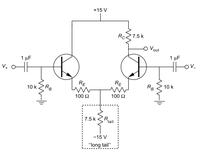Farad22
Junior Member level 2
Hi all,
I have the following schematic attached of an AC-coupled differential pair. I would like to know how to choose the right value of the base DC bias resistors (Rb)? Many times I see values used between 10K - 100K. What factors decide how we should choose the value of these resistors? Thanks in advance.

I have the following schematic attached of an AC-coupled differential pair. I would like to know how to choose the right value of the base DC bias resistors (Rb)? Many times I see values used between 10K - 100K. What factors decide how we should choose the value of these resistors? Thanks in advance.
